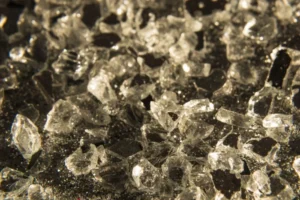Have you ever held a beautiful stone in your hand and wondered—is this agate or carnelian?
You’re not alone. As someone who has spent years collecting and studying gemstones, I can tell you: telling them apart isn’t just about looks—it’s about understanding their story, value, and energy.
In the world of crystals and minerals, few comparisons spark more confusion (and fascination) than agate versus carnelian. Whether you’re a jewellery maker, a healing crystal enthusiast, or simply curious, knowing the difference helps you appreciate these stones more deeply—and avoid costly mistakes.
Drawing from my personal experiences in gem shows across Europe, interviews with expert gemologists, and in-depth research, this guide will walk you through everything you need to know—clearly, simply, and without jargon.
What Are Agate and Carnelian, Really?
Before we dive into differences, let’s get the basics straight.
Agate is a variety of chalcedony, which is a form of microcrystalline quartz. It’s known for its fine banding, almost like the rings of a tree.
Carnelian, on the other hand, is also a variety of chalcedony—but usually without visible bands. It boasts a rich, fiery colour palette, from sunset orange to deep reddish-brown.
Dr. Laura Thompson, a geologist at the Natural History Museum in London, explains:
“While both are chalcedony, carnelian gets its distinct colour primarily from iron oxide, whereas agate’s patterns form from layers of different mineral impurities over time.”
In simpler terms: they’re siblings from the same mineral family—but each has its own personality.
Agate vs. Carnelian: Key Differences Explained
1. Appearance and Colour
When I first started attending gem markets, the easiest trick the sellers shared was: look for banding.
- Agate usually displays clear, curved bands or swirls, often in muted tones like white, grey, or blue.
- Carnelian typically shows a uniform, translucent to opaque reddish-orange hue, with little to no visible banding.
✨ Real-world tip:
Under strong light, agate often reveals hidden layers. Carnelian glows warmly, almost like embers.
2. Formation and Location
Agate forms in volcanic rocks and ancient lava, cooling slowly over millions of years. Its bands record each new mineral-rich layer like a diary.
Carnelian forms similarly, but the iron content and environmental conditions boost its warm colours.
Where they’re found:
- Major agate deposits: Brazil, Uruguay, India, and Madagascar.
- Carnelian hotspots: India (especially Gujarat), Brazil, and Egypt.
During a visit to Jaipur’s famous gem market, an artisan showed me agates sourced from Madagascar that were cooler in tone, while their Indian carnelian stones had deep, spicy hues—almost like saffron.
3. Hardness and Durability
Both agate and carnelian rank about 6.5 to 7 on the Mohs scale, meaning they’re durable enough for everyday jewellery.
However, in my experience, agate tends to be slightly tougher because of its layered structure, while softer carnelian can scratch more easily if mishandled.
If you’re choosing a stone for a ring or bracelet that will face daily knocks, agate might last longer.
4. Symbolism and Uses
Both stones have rich histories:
- Agate has been prized since ancient times for its grounding and protective properties.
- Carnelian was worn by Egyptian pharaohs as a symbol of vitality and courage.
In modern crystal healing:
- Agate is often linked to balance and harmony.
- Carnelian is associated with creativity, motivation, and confidence.
Personally, whenever I feel creatively stuck, I carry a small carnelian in my pocket—and whether it’s placebo or genuine energy, I always feel a bit more fired up!
5. Price and Value
Both stones are relatively affordable compared to other gems, but high-quality carnelian (deep colour, high translucency) tends to fetch higher prices than most agate.
🔍 Buyer’s note:
Dyed agate is common! Some vendors enhance agates to look like carnelian, so always buy from trusted sources.
An article from the Gemological Institute of America (GIA) confirms:
“Many bright orange ‘carnelian’ stones in the market are actually heat-treated or dyed agates.”
How to Tell Agate from Carnelian (Even If You’re a Beginner)
Here’s a simple test you can try:
| Feature | Agate | Carnelian |
|---|---|---|
| Banding | Obvious, layered bands | Minimal or no banding |
| Colour | Cool to warm tones | Warm red, orange, reddish-brown |
| Light Test | Layers visible under light | Even, glowing translucence |
| Common Enhancements | Dyed to enhance colours | Sometimes heat-treated |
When in doubt, consult a gemologist—or at least use a good jeweller’s loupe (10x magnification) to examine the stone more closely.
FAQs About Agate and Carnelian
Is carnelian a type of agate?
Technically, yes—they’re both types of chalcedony. However, carnelian is considered its own variety because of its unique colouration and lack of strong banding.
Can agate be orange like carnelian?
Yes! Some orange agates exist naturally, but many are dyed. True carnelian has a distinct warmth and evenness that dyed agate often lacks.
How can you tell if carnelian is real?
Look for a natural, slightly uneven colour. If it’s too perfect or fluorescent, it might be dyed or synthetic. Also, genuine carnelian feels cool to the touch and is heavier than glass imitations.
Actionable Takeaways
- Use a light test: Hold the stone up to strong light to spot banding or glow.
- Buy from reputable dealers: Especially if you’re investing in high-grade stones.
- Trust your instincts: Real stones have a depth and energy that’s hard to fake.
- Learn slowly: Over time, your eye will naturally sharpen.
And if you want an expert-verified breakdown, visit trusted resources like GIA.
Final Thoughts: Agate and Carnelian Both Have Their Magic
In the end, whether you choose agate or carnelian, you’re holding a piece of Earth’s ancient artistry.
Each stone carries not just beauty, but millions of years of history in its heart.
Personally, my collection includes both—each serving its own mood and purpose. Some days I need the calm stability of agate. Other days, I crave the fiery push that only carnelian can offer.
Which one speaks to you today?
I’d love to hear your experiences with agate or carnelian! Share your favourite stone story in the comments below.
Want to learn about storage of Gemstones? Read Here!
If you want to read more such articles then make sure to visit our homepage!




